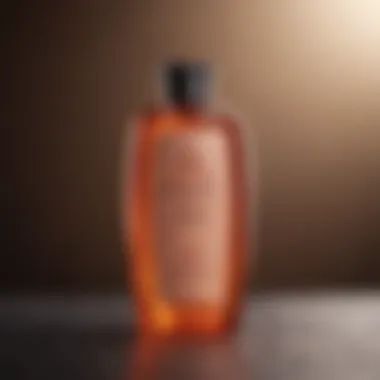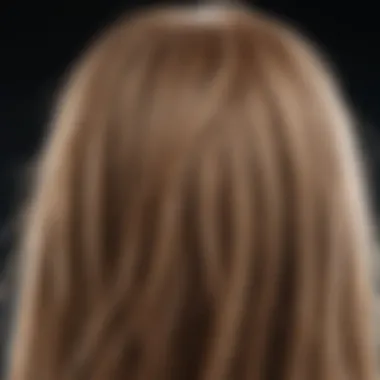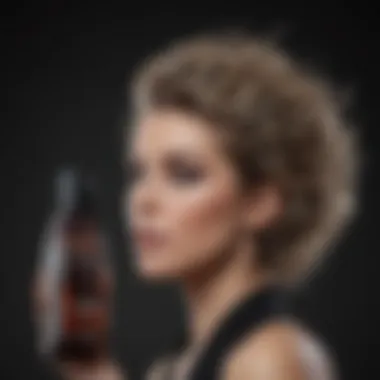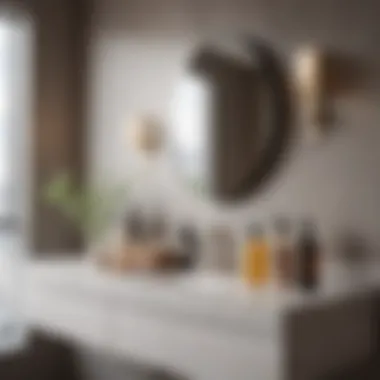Best Shampoo for Static Hair: Solutions for Smoothness


Intro
Static hair can disrupt not only your appearance but also your confidence. A common problem, especially in dry climates or during cold months, it often leaves hair looking unkempt and frizzy. Understanding the core reasons behind this phenomenon is crucial when seeking solutions. Static occurs when there is an imbalance of charges in the hair, leading to a lack of moisture and an excess of electrons. This imbalance can be exacerbated by various factors such as weather conditions, hair type, and even the products used in your hair care routine.
This article aims to provide a deep dive into effective methods for managing and styling static hair. It will explore the different types of shampoos available on the market, the key ingredients that can counteract the effects of static, and specific product recommendations suitable for diverse hair types. Additionally, we will address complementary hair care practices that can enhance the overall health and appearance of your hair. By taking an informed approach, individuals can effectively choose the right products and techniques to maintain smooth and manageable hair.
Understanding Static Hair
Static hair is more than just a minor inconvenience; it can significantly affect one's appearance and confidence. Understanding the topic of static hair is crucial because it lays the foundational knowledge needed to choose effective solutions. It leads to better decisions regarding hair care products and practices. For many individuals, identifying what causes static and how to counteract its effects can transform their daily grooming routine. Addressing static hair is not only about aesthetics but also about hair health and overall hair management.
Definition and Characteristics
Static hair refers to hair that stands away from the head or sticks to surfaces instead of laying flat. This phenomenon often occurs when there is a lack of moisture in the hair and environment, leading to an imbalance of electrical charges. Characteristics of static hair include frizz, flyaway strands, and a generally unruly appearance. Such behaviors often lead to frustrations during styling and can detract from the overall polish of one's look. Knowing what static hair is can help in finding appropriate remedies.
Common Causes of Static
Static in hair can arise from several factors. Dry air is one of the most prevalent contributors, especially during winter months when heating systems are in operation. Additionally, synthetic fabrics, such as polyester, can generate static electricity through friction.
Other causes include:
- Over-washing: Shampooing too frequently can strip natural oils from the hair, leaving it dry andstaticky.
- Lack of hydration: Not drinking enough water can affect the moisture levels in hair.
- Heat styling: Frequent use of hair dryers, curling irons, or straighteners can damage the hair cuticle.
Understanding these causes is the first step toward managing and resolving the issue of static.
Identifying Your Hair Type
Understanding your hair type is crucial when selecting the right shampoo to address static hair. Different hair types have unique characteristics, and this means they respond differently to various products. Recognizing whether your hair is fine, thick, curly, or color-treated helps in choosing shampoos that effectively reduce static and contribute to smoothness.
Knowing your hair type also assists in aligning your product use with other hair care techniques. It can provide insights into how to enhance the natural texture of your hair and manage the static that often accompanies frizz. Invalid assumptions about your hair type may lead to choosing inappropriate products that could worsen the condition of your hair.
Fine Hair
Fine hair is often more prone to static because it can lack the weight needed to keep it grounded. Therefore, selecting a lightweight shampoo is essential. Look for products specifically designed for fine hair that offer moisture without heaviness. Ingredients such as lightweight silicones can help tame flyaways without weighing down the hair. This makes it easier to manage static. Regular washing is important, but over-washing can strip natural oils. Aim for three to four washes a week to maintain moisture levels without introducing excess static.
Thick Hair
Thick hair can also experience static, particularly in dry conditions. It's often more resilient but may need a heavier, moisturizing shampoo to combat dryness. Look for shampoos containing rich oils and butters that can hydrate and seal moisture into the hair shaft. Your washing routine can be less frequent, around twice a week, to prevent the hair from becoming overly dry. Using leave-in conditioners can provide additional moisture and reduce friction, minimizing static.
Curly Hair
Curly hair tends to be drier due to its structure, which can contribute to static. For this hair type, shampoos designed for curls typically contain formulation elements like humectants, which attract moisture. This helps to keep curls hydrated. It is advisable to use sulfate-free shampoos as sulfates can strip much-needed moisture. Wash curly hair every 7 to 10 days to maintain its natural oils. Pair your shampoo with a good conditioner to help combat static and enhance definition of curls.
Color-Treated Hair
Color-treated hair requires special attention, as the coloring process can compromise the hair's integrity, making it more susceptible to static. It’s beneficial to use shampoos that are sulfate-free and specifically formulated for color protection. These products help maintain vibrant color while also providing the necessary moisture to reduce static. Aim for a washing routine that revolves around two to three times a week. Incorporating weekly deep conditioning treatments can significantly improve texture and minimize static by replenishing lost nutrients.
"Identifying your hair type is the first step in your journey to eliminate static and enhance smoothness."
By recognizing these different types of hair and the specific shampoos that cater to their needs, you empower yourself to make informed choices. This approach not only helps in successfully tackling static but also promotes the overall health and appearance of your hair.
Key Ingredients to Combat Static
When dealing with static hair, understanding the right ingredients in shampoo is crucial. Selecting products with effective components can help reduce frizz and smoothen hair. Certain ingredients specifically target the issues that cause static, making them vital in any shampoo aimed at tackling this concern.


In this section, we’ll explore four key categories of ingredients that play a significant role in combating static. Knowing these can guide you in choosing an informed shampoo that matches your hair type and needs.
Silicones
Silicones are often included in hair care products due to their smoothing properties. These compounds coat the hair shaft, creating a barrier that helps to lock in moisture. This action significantly reduces friction between strands, thereby diminishing static.
Common silicones found in shampoos include dimethicone, cyclopentasiloxane, and amodimethicone. Each varies in how it interacts with hair, but all contribute to a sleeker appearance. When using silicones, it is important to consider how often your hair is washed. Some silicones can build up, so regular cleansing with a clarifying shampoo may be necessary for those with fine or oily hair types.
Oils and Butters
Natural oils and butters provide nourishment to hair and are valued for their hydrating properties. Ingredients such as argan oil, coconut oil, and shea butter penetrate the hair shaft and deliver moisture directly. They also create a protective layer that prevents moisture loss, which is essential in static-prone environments.
These ingredients can combat dryness that often leads to static. Incorporating shampoos with oils and butters is beneficial for those with drier hair types. For optimal results, using a conditioner or leave-in treatment containing these elements can further enhance smoothness and shine.
Humectants
Humectants are substances that attract moisture from the environment into the hair. Ingredients such as glycerin, aloe vera, and honey are common humectants found in shampoos.
Using shampoos that include humectants is essential when dealing with static hair, especially in dry climates. They help maintain the moisture balance in hair, reducing the chances of frizz and static. However, in very humid conditions, it is important to monitor your hair because excessive moisture absorption may have the opposite effect, causing hair to feel heavy or sticky.
Proteins
Proteins are vital for hair strength and resilience. Hydrolyzed keratin, wheat protein, and silk protein are examples of effective proteins used in shampoos. These ingredients help to replenish damaged hair, making it more resistant to breakage and static.
When hair is strong, it tends to behave better overall, which can minimize frizzy and static-prone situations. For those with colored or heat-treated hair, incorporating protein-rich shampoos can significantly enhance the health of hair and reduce static concerns.
The right combination of these ingredients can make a noticeable difference in managing static hair. Knowing what to look for is the first step in achieving smooth locks.
Review of Top Shampoos for Static Hair
Static hair can disrupt the appearance of any hairstyle, making it look frizzy and unkempt. Therefore, selecting the right shampoo is essential to mitigate these effects. The shampoos formulated specifically for static-prone hair often contain unique ingredients that offer benefits beyond just cleansing. They help in improving moisture retention, which is critical since dry hair is more prone to static. Understanding the benefits of these shampoos, alongside their features, can help you choose a product that effectively addresses your specific hair needs.
Shampoo A: Features and Benefits
Shampoo A stands out in the crowded hair care market for its advanced formula designed to combat static hair. This shampoo is infused with silicones that smooth the hair cuticle, reducing friction between strands. The result is a sleek finish and minimized flyaways. Users have reported noticeable softness and shine after just a few uses. It's suitable for various hair types, making it versatile.
Shampoo B: Features and Benefits
Shampoo B integrates a blend of natural oils, such as argan oil, which nourishes the hair while combating static. This shampoo deeply moisturizes, preventing dryness that can lead to static. The lightweight texture allows it to be easily absorbed, without leaving any heavy residue. It works wonders for color-treated hair, maintaining vibrancy while controlling frizz and static.
Shampoo C: Features and Benefits
Shampoo C utilizes humectants like glycerin that draw moisture into the hair, providing long-lasting hydration. This is crucial for those living in dry climates where static is more likely. The creamy formula also helps detangle hair, reducing breakage during the brushing process. Users typically find their hair is more manageable with minimal static.
Shampoo D: Features and Benefits
Shampoo D is a premium product enriched with proteins that strengthen the hair structure. This helps reduce static by repairing damage and making hair more resilient against environmental factors. Users of this shampoo often mention improved texture and less frizz, making it ideal for individuals with thick or curly hair types. Additionally, it has a pleasant scent that lasts throughout the day.
Choosing the right shampoo is a crucial step in maintaining smooth, static-free hair. The combination of effective ingredients can make a significant difference.
Additional Hair Care Techniques
In the pursuit of combating static hair, shampoos alone do not provide a complete solution. Additional hair care techniques play a crucial role in maintaining smoothness and vitality. These techniques enhance the effectiveness of shampoo and contribute to overall hair health. They offer various benefits, such as moisture retention, protection from environmental damage, and improved manageability.
Conditioners and Leave-ins


Conditioners are an essential part of any hair care routine. They work to restore moisture that may be stripped away during the washing process. Regular use of a good conditioner can significantly reduce static hair.
Leave-in conditioners are particularly effective for preventing static. They provide ongoing moisture and protection throughout the day. Applying a leave-in product can help keep hair smooth and manageable, especially in dry environments. Look for products containing natural oils or silicones for best results. These ingredients help to coat the hair strands, reducing friction that often causes static.
Hair Oils and Serums
Hair oils and serums are excellent companions to shampoos and conditioners. They offer additional moisture and smoothing properties, crucial for static-prone hair. Using a hair oil can aid in locking in moisture, providing a protective barrier against dry air.
Natural oils such as argan oil, coconut oil, and jojoba oil are popular choices. They nourish the hair, making it softer and less prone to frizz. Serums, on the other hand, often contain silicones that create a sleek finish while reducing flyaways. Applying a small amount of oil or serum, particularly to the ends, can significantly improve hair texture.
Heat Protection Products
Heat protection products serve as a safeguard against the damaging effects of heat styling tools. Static can be exacerbated by heat damage, making it essential to use these products. They create a barrier that minimizes moisture loss when using blow dryers, straighteners, or curling irons.
Selecting a heat protectant is vital for those who often style their hair. Look for sprays or creams that not only protect but also add moisture and shine to the hair. Ingredients such as glycerin or panthenol are commonly effective. These help maintain the integrity of the hair while preventing static.
High-quality additional hair care techniques complement the best shampoos by addressing the factors that contribute to static hair.
Implementing these practices into your routine can lead to a significant improvement in your hair’s texture and appearance. Consider your specific hair needs when choosing products, as this will further enhance their benefits.
Lifestyle Factors Influencing Static Hair
Determining how lifestyle factors influence static hair is crucial for understanding how to maintain its smoothness. Many individuals overlook these elements, believing that only products matter. However, lifestyle choices play a significant role in how hair behaves. Factors such as climate, diet, and the tools used in styling can either exacerbate or alleviate static. By gaining insights here, individuals can make informed choices that lead to healthier and smoother hair.
Climate Considerations
The climate in which one lives can greatly affect hair's tendency to static. For instance, low humidity environments can leave hair dry and more susceptible to static cling. This phenomenon often occurs in winter months or in arid regions. On the other hand, humid weather can make hair feel frizzy, complicating the static problem further.
When it comes to climate, consider these points:
- Seasonal Changes: During winter, the cold air holds less moisture. As a result, hair loses its natural hydration, making it prone to becoming static.
- Humidity: High humidity can cause the hair shaft to absorb moisture, leading to swelling and increased friction, which creates static.
- Indoor Environment: Central heating can dry out the air in homes, contributing to dry hair and static.
Paying attention to these elements can guide individuals in selecting products that are tailored to their local climate.
Diet and Hydration
What you consume has a direct impact on your hair's health. Diet plays a role in maintaining adequate moisture levels in both hair and scalp. Foods rich in vitamins and minerals are essential for keeping hair nourished and hydrated.
Consider incorporating the following into your diet:
- Omega-3 Fatty Acids: Found in fish like salmon, these can help maintain the moisture barrier of your hair.
- Vitamins: Vitamin E and biotin are crucial for healthy hair and can be found in nuts, seeds, and green leafy vegetables.
- Hydration: Drinking plenty of water ensures that hair remains hydrated from within.
A well-balanced diet not only enhances overall hair health but also helps in reducing static by ensuring consistent hydration.
Styling Tools and Techniques
How hair is styled can also lead to static buildup. Using certain tools and techniques might contribute to unwelcomed static. Understanding the right tools can mitigate this issue effectively.
Key considerations include:
- Material of Tools: Using metal or plastic brushes can cause more friction than brushes made from natural fibers. Consider using wooden or boar bristle brushes.
- Heat Tools: Overuse of heat styling tools can dry out hair and make it more prone to static. It is vital to use heat protection products when styling.
- Technique: Gentle handling while brushing or styling can reduce static. Avoid vigorous rubbing or excessive tugging.
By choosing proper styling tools and adopting gentler techniques, static can be reduced significantly. This awareness allows for better hair management, contributing to an overall smooth appearance.


Practical Tips for Everyday Care
The management of static hair is more than just using the right shampoo; it involves a holistic approach to hair care. This section illuminates practical tips that focus on everyday practices to prevent and mitigate static. By implementing these strategies, individuals can maintain smoother hair and reduce frizz, leading to a more polished appearance.
Brushing Techniques
Selecting the right brushing technique can have a significant effect on static hair. A gentle approach is crucial. Avoid using plastic brushes, which can create more static due to the friction they produce. Instead, opt for brushes with natural bristles or wooden brushes. These materials help reduce static and distribute natural oils throughout the hair.
- Use a wide-tooth comb: This is especially effective for detangling without creating excessive friction.
- Brush hair when dry: Wet hair is more susceptible to damage and static.
- Start from the ends: Work your way up to minimize breakage while brushing.
By paying attention to how you brush, you can greatly reduce static cling that often arises from rough and aggressive handling.
Proper Washing Routine
Establishing a proper washing routine is fundamental. Take note of the frequency of washing your hair, as over-washing can lead to dryness and increased static. Aim for washing your hair 2-3 times a week, unless it becomes overly oily. Always use lukewarm water, as hot water can strip away essential moisture, exacerbating static issues.
When applying shampoo,:
- Use a small amount, focusing on the roots.
- Gently massage the scalp to stimulate circulation without causing friction.
- Rinse thoroughly to remove any buildup.
Conditioner plays an equally important role in your washing routine. Always apply a conditioner after shampooing, starting from mid-length to the ends to avoid greasing the roots. Leave-in treatments or masks once a week can also provide extra moisture and help combat static.
Remember: Consistency is key. Adhering to a routine will produce noticeable improvements in the texture and look of your hair over time.
Common Misconceptions About Static Hair
Addressing the common misconceptions about static hair is crucial in understanding how to effectively manage and prevent it. Many people hold inaccurate beliefs about what causes static hair and how to treat it. These misunderstandings can lead to ineffective hair care practices or unnecessary frustration. By clarifying these myths, individuals can adopt a more strategic approach to their hair care routine, making informed decisions that result in improved hair smoothness and reduced static.
Myths About Shampoo
One prevalent myth is that all shampoos can cause static hair. While some formulas may strip essential moisture from hair, not all shampoos are created equal. Many products contain specialized ingredients that target frizz and static issues. For instance, shampoos rich in silicones can help coat the hair, providing a barrier against static. It is essential to read labels and select shampoos designed for your specific hair type.
A common belief is that anti-dandruff shampoos always lead to static due to their strong formulations. This is not universally true. Many modern anti-dandruff shampoos now include moisturizing agents that can help to maintain hydration. Recognizing the right product for your needs matters more than just the category.
Another common misconception is that using a clarifying shampoo is always beneficial for controlling static. Clarifying shampoos can remove buildup from products but may also strip natural oils from the hair. Overuse can lead to dryness, which often exacerbates static issues. Therefore, balance is key. Incorporating a gentle shampoo alongside clarifying options may yield better results without compromising moisture.
Static and Dryness Connections
There exists a strong connection between dryness and static hair, which leads to misunderstandings about their relationship. Many people believe that static only occurs in dry hair, which is only part of the truth. While dry hair is indeed more prone to static due to lack of moisture, even well-hydrated hair can develop static in certain conditions.
For example, during the winter months or in low humidity environments, hair can become electrically charged due to friction. This charge intensifies static regardless of the moisture levels in the hair. Therefore, individuals may find themselves surprised when beautifully moisturized hair still experiences static.
To counteract this, using moisture-enhancing products can help. Applying leave-in conditioners or serums can provide much-needed hydration that aids in minimizing static. Understanding that static can be influenced by environmental factors, rather than just hair health, is essential in adapting one’s hair care routine.
Thus, dispelling these myths enables better management of static hair through more informed product choices and hair care routines. Armed with this knowledge, readers can take proactive steps to enhance their hair's appearance and tactile quality.
The End
In this article, the discussion has centered on how to address the persistent issue of static hair. Understanding the key factors that contribute to static is crucial. Many individuals struggle with flying, unmanageable hair, particularly in certain climates. By recognizing the causes and learning how to mitigate them, one can maintain a healthier and smoother appearance.
The exploration of vital ingredients in shampoos has illuminated the best solutions available in the market. Specific elements like silicones, oils, and humectants play a pivotal role in combating static. These formulations aim to provide hair with adequate moisture and protection against environmental factors that induce frizz and static. Additionally, knowing one's hair type and tailoring hair products accordingly can greatly enhance overall hair health and manageability.
In summary, choosing the right shampoo and incorporating a well-thought-out hair care routine can vastly improve the quality of hair. From conditioners to heat protection products, many options complement the selected shampoos to ensure the desired outcome. Misconceptions about static hair and its relation to dryness further highlight the need for informed choices in hair care practices. Through this comprehensive guide, users can navigate the complexities of static hair and achieve smoother, more controlled hairstyles.
"Selecting the right shampoo not only helps in controlling static but also contributes to overall hair health, which can significantly enhance one's appearance and confidence."
Recap of Important Points
- Understanding Static Hair: Grasp the definition and common causes of static hair, including environmental influences.
- Identifying Your Hair Type: Take into account the variations among fine, thick, curly, and color-treated hair to find suitable products.
- Key Ingredients: Recognize the importance of silicones, oils, humectants, and proteins in effectively combating static.
- Product Recommendations: Review top shampoos specifically tailored for tackling static issues.
- Additional Care Techniques: Incorporate conditioners, serums, and heat protectants into your routine for maximum effectiveness.
- Lifestyle Factors: Be aware of how climate and personal habits affect hair condition.
- Practical Tips: Learn proper brushing and washing techniques for best results.
- Common Misconceptions: Debunk myths surrounding static hair to make informed choices.
By internalizing these points, readers can effectively care for their hair, reducing static and improving its overall appearance.







